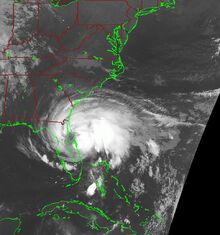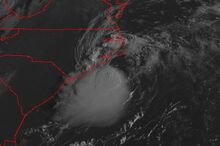
Hurricane Walter at peak intensity on December 23
Hurricane Walter was the first offseason major Atlantic hurricane in recorded history, forming in mid-December of the 2016 Atlantic Hurricane Season. It was also the longest-lived offseason Atlantic tropical cyclone.
Walter was most well known for making landfall in Christmas Eve in Florida, causing 120,000+ power outages in Florida, Georgia and Alabama.
Meteorological History[]

The track of Walter. Water did not become a hurricane until December 22, 8 days after formation.
A tropical wave exited the coast of Africa on December 12. The tropical wave was given a "near zero percent" chance of tropical development by the NHC. However, convection increased at the center on December 13. Tropical Depression Twenty-Three was declared on December 14 at 4AM EST, located about 200 miles southwest of the Cape Verde Islands. At 10AM, the storm strengthened into Tropical Storm Walter with 40 MPH winds, but little thunderstorm activity. Tropical Storm Walter weakened into a Tropical Depression on December 16 with 35 MPH winds. Walter battled through water temperatures of just 62 degrees Fahrenheit, but managed to stay intact for 12 days. At this point, Walter was about 600 miles east of the Lesser Antilles; Walter was subsequently re-classified as Subtropical Depression Walter on December 17. On December 18, Walter regained tropical characteristics and strengthened back into a minimal tropical storm. At this point, Walter was expected to dissipate into an extratropical cyclone by December 20.

Walter moving ashore
Walter battled through wind shear and cold waters as it fluctuated between Tropical Storm and Tropical Depression status for the next four days before entering the Gulf of Mexico on December 22. Here, decreased wind shear and warm waters of 82 degrees Fahrenheit gave the storm a chance of intensification. At 4AM EST on December 22, Walter strengthened to 45 MPH winds. At the 10AM advisory, Walter strengthened to 70 MPH winds. At the 4PM advisory, Walter had strengthened into a Category 1 hurricane with 90 MPH winds. By 10PM, Walter had reached Category 2 hurricane status with 105 MPH winds. At 4AM, it was reported that Walter had reached 115 MPH winds, becoming the first offseason major hurricane in Atlantic history. Further strengthening was not predicted as the storm was initially slated to make an unusual landfall in Alabama late on December 23. However, Walter made a "great loop", retaining its Category 3 hurricane status and reaching its peak intensity of 120 MPH winds and 946 mbar pressure at 4PM on December 23. Walter then weakened early on December 24 as it took an expected turn into northwestern Florida, becoming a Category 1 hurricane by the 10AM advisory. Walter then made landfall near Tallahassee, Florida at 4PM on December 24, causing heavy rains and thunderstorms. By 7PM, Walter had weakened to a Tropical Storm as it moved into western Georgia.
As Walter made landfall, the storm essentially split into two non-tropical areas of low pressure. One moved into the Appalachian Mountains, while the other turned farther East (the one that was still officially considered Walter). Walter weakened to a Tropical Depression by early Christmas Day, but continued to cause heavy rains. Walter subsequently moved eastward and moved off the North Carolina Coast on December 26.
Heavy rains were reported all over the Southeast on December 25 (Christmas Day). Over 120,000 people in

Hurricane Walter's remnant on December 26
Florida, Georgia and Alabama reported power outages that day. Torrential rains also occurred as far north as North Carolina, with Raleigh, NC seeing 3.05 inches of rain that Christmas.
| City | Rainfall (inches) | Max winds |
|---|---|---|
| Atlanta, GA | 4.85 in | 50 MPH |
| Talahassee, FL | 5.93 in | 75 MPH |
| Jacksonville, FL | 4.88 in | 65 MPH |
| Mobile, AL | 3.73 in | 60 MPH |
| Savannah, GA | 2.90 in | 50 MPH |
| Charleston, SC | 4.85 in | 60 MPH |
| Raleigh, NC | 3.05 in | 50 MPH |
| Myrtle Beach, SC | 6.72 in | 50 MPH |
